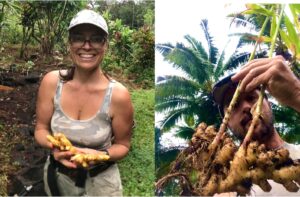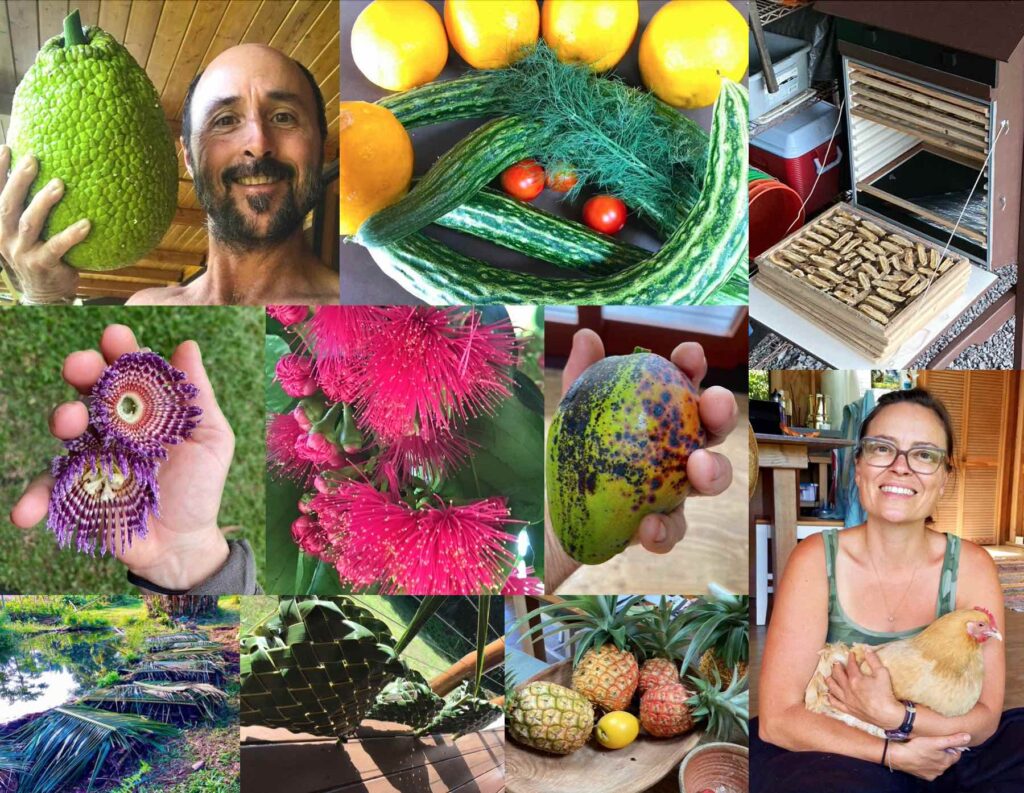This page was originally written before we found land. We compiled a narrative of what we imagined community would look like on our ideal land. It is worth a read, and found here.
Now that weʻre at Iolani, a day in the life has become a real narrative, so weʻve put together this new page to give you a taste.
Raising and tending and diversifying our food is probably the focus that shapes our lives most days. To give you a taste of that experience, Iʻll transcribe our profile from the WWOOF site:
We are Diga and Jasmine, a down-to-earth couple who love growing and preparing local food. We steward Iolani, a seven acre tropical homestead amidst towering old growth mango trees, singing coqui frogs, and a plethora of exotic fruits growing on multiple hues of green foliage. We seek connections with people who want to make the world a better place, using land work, food processing, and relationship-building as the medium. We share our meals with gold-dust day geckos, wash off the dayʻs work in outdoor showers, and enjoy our days off at the coast, making music, or going on excursions in nature.

Food self-sufficiency requires so many skills! In terms of traditional farming, yes, you will be planting seeds, maintaining greenhouse/outdoor nurseries, and planting annuals/perennials in the ground. Here in the tropics where so many of our staples are propagated vegetatively, you could just as easily find yourself harvesting and planting cuttings of perennial greens, nitrogen-fixing ground-covers, and living fenceposts. Or spreading propagules of chayote, banana, pineapple, air potato, and cassava. In terms of harvest, you will become adept with a variety of picking poles for breadfruit, avocado, or papaya. You might find yourself doing ground crew on a coconut harvest. Depending on the season, youʻll dig uhi (Hawaiian yam), taro, cassava, ginger, turmeric, achira, leren, and other roots, cleaning them with water and brushes. De-taping and spreading cardboard sheet mulch and planting it with perennial ground-covers is an on-going activity, as we transition away from grass. You will spend some time operating hand-saws and loppers to remove invasive weed trees and expand orchards. You might be surprised to find out how much time it takes to PROCESS local foods, once harvested. To make dried fruit and gluten-free local flours, youʻll process, slice, and/or grate jackfruit, banana, breadfruit, and cassava (along with a whole list of more infrequent foods), taking responsibility to tend our 2 solar dehydrators. Youʻll use the manual Saladmaster to grate everything from green papaya salad to sauerkraut cabbage. Youʻll learn to use a machete to crack coconuts, and a butter-knife to remove the meat. Youʻll make your own coconut cream, using a food processor, and learn to enjoy coconut in many other ways, from spoon-meat to sprouter. Regular maintenance of food-growing areas requires “chopping and dropping” work, using a variety of sickles or hand-pruners to cut back biomass plants into mulch piles built under crop trees. At least once a week youʻll work with our guest permaculture designer, who in addition to his mastery of permaculture theory, is also a wealth of knowledge about tropical permaculture species and techniques. In season, Jasmine will walk you through coffee and cacao harvesting, processing, and fermenting. You will harvest seed from nitrogen-fixing crops such as pigeon pea and crotalaria, shelling them in readiness for the next planting. A portion of your time will be committed to keeping your space clean and to regular infrastructure maintenance, which can include everything from cleaning mosquito screens, to operating a pressure washer, mopping, dusting, sweeping, and weeding around the edges of structures. Youʻll rotate through work-parties that are facilitated by any of the landʻs three residents, to ensure you can access the breadth of our knowledge. Youʻll have access to electronic curriculum materials and to our online land work-sharing project, if youʻd like to dig deeper into the information-based theory and practice of permaculture.

We currently have two open cabins—each would ideally house two people. Each is a comfortable and self-sufficient unit, with equipped kitchenette (cold food storage, propane 2-burner stove), outdoor shower, hot water, composting toilet, wood floor, mosquito screen, bed, closet, electricity, and internet (nominal fee). Our Bridge House structure (queen bed) is a studio space, ideal for a couple who are comfortable with living close together or for the right single applicant. Our OWL House can be configured in different ways to accommodate either one individual; two friends who are intimate enough to share semi-private toilet and shower, but sleep in separate spaces; or a couple. Most meals will be taken individually in the WWOOFers own accommodations. WWOOFers are expected to make daily use of foods from the land, which include plentiful year-round starch (cassava, breadfruit, air potato, `uhi), year-round perennial greens (bele spinach, chaya, Okinawan spinach, sweet potato, katuk, longevity spinach, sissoo, and many more), honey, coconut and its products, avocado (8-9 months of the year), papaya, chayote, and, seasonally, citrus, mulberry, jackfruit, abiu, rollinia, mountain apple, starfruit, and surinam cherry. Seasonally we have perennial legumes, squash, herbs, ginger, turmeric, lemongrass, galangal, hot/sweet peppers. We provide coconut/avocado oil, apple cider vinegar, salt, dry beans, and other staples. Meat, if wished must be purchased individually. Regular group meals and food processing sessions will happen in the farmʻs main house kitchen, where we will provide one meat meal per week.

We enjoy many practical skills related to self-sufficiency, such as coconut-frond weaving, bamboo-building, and beekeeping. Youʻll for sure get a chance to pick up some of these arts if you are interested. Weʻve both got background in Zimbabwean marimba ensemble, and will sometimes play music together on some of our many instruments. Diga plays piano and writes; Jasmine knits and enjoys the fiber arts. Our neighborhood has many other small farms and self-sufficiency homesteads, some of which youʻll get introduced to through our weekly Trading Post or through hyper-local social networks you can join. Within walking distance through cool, shady dirt roads and forest trails (1 hr) are several spots where you can get to the coast and get wet in tide pools. A 20 minute walk away is a retreat center that often offers regular paid or free yoga, Qi Gong, sound healing, or other classes. Pahoa is a 25 minute drive, and can most often be reached within an hour hitchhiking (pretty common and easy in our area). There youʻll find a health food store, banks, post office, supermarket, hardware, pharmacy, and other smaller businesses. The city of Hilo is 1 hr away driving. It is possible to coordinate your timing to catch a bus from Pahoa to Hilo for the day. Puna has several happenings at public spaces and at eco-retreats, including a Bee Dance, Ecstatic Dance, drum circle at the Seaview lawn, Kehena Beach, and Maku`u Farmerʻs Market. Unfortunately, these are all at least 30 minutes drive away. We will sometimes be able to help WWOOFers with a lift to Pahoa to take care of laundry or shopping essentials, but are not able to commit to a regular schedule at this time.

